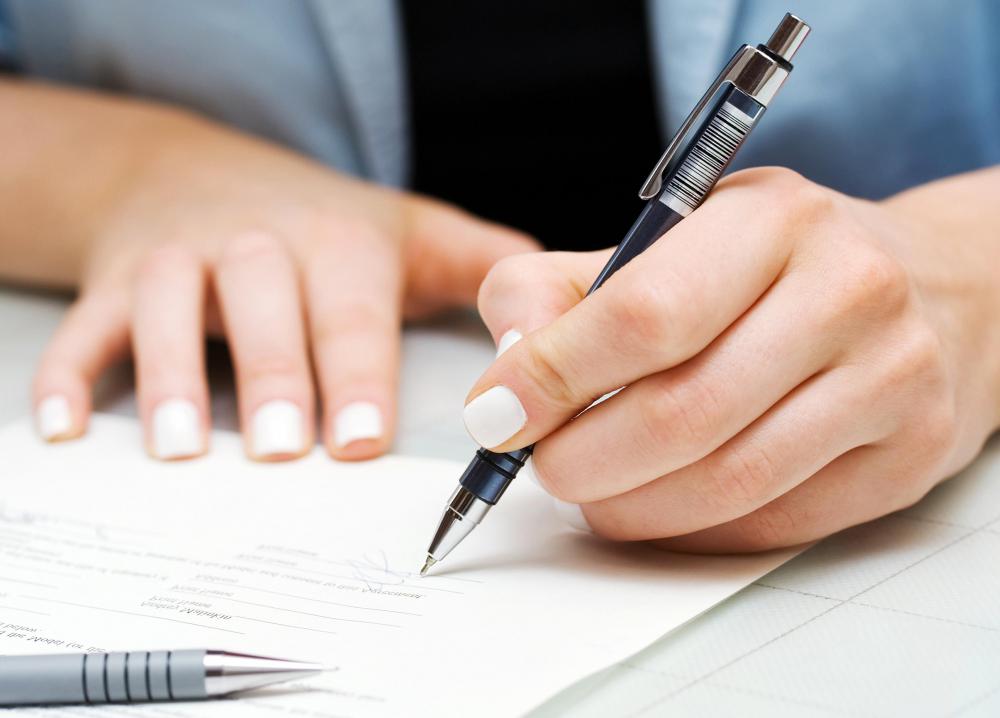At WiseGEEK, we're committed to delivering accurate, trustworthy information. Our expert-authored content is rigorously fact-checked and sourced from credible authorities. Discover how we uphold the highest standards in providing you with reliable knowledge.
What Should I Know About Writing Cursive?
Most people's signatures are made by writing in cursive. Cursive is a form of handwriting in which all the letters are joined together. It is also commonly used when taking notes or writing a personal letter, as it is quicker than writing in print. With the speed and convenience of the computer, not many people are writing cursive any longer. As long as people have to sign their name, though, it will always be around.
Writing cursive involves slanting your paper at a 45 degree angle. This allows the letters to flow in one direction without having to write sideways. The direction of the slant depends upon whether a person is left- or right-handed.

When writing cursive, never remove your pencil from the paper in the middle of the word. All the letters are connected together through a series of loops. This gives the letters an appearance of flowing together. Letters that are finished at the top connect to the next letter with a horizontal line. Letters that are finished at the bottom connect to the next letter with a diagonal line.

Lower case letters, when writing cursive, always begin at the highest point. Upper case letters will vary depending upon what letter you are writing. Make sure all lower case letters that are similar in size, such as "a" and "e" are the same height when written. All the words should be one letter width apart, making them equally spaced.
In order to learn how to write in cursive, you will need to know how each letter is written in the lower and upper case forms. You can learn this from a book titled D'Nealian Handwriting Cursive ABC Book: Handwriting Practice Book, written by Donald N. Thurber and Patricia Barbee. This book is available at most chain bookstores.

Writing cursive takes a lot of practice. Practice tracing the letters on cursive handwriting sheets. You can find them online at several different websites. Most provide practice sheets for each letter of the alphabet, in lower and upper case. The sheets are available with all or minimal tracing options.
Learning how to write your name in cursive is a big step in mastering the process. Your signature is the one thing you will write in cursive on a regular basis, if nothing else. Most legal forms require you to first print your name, then sign it. After learning how to write in proper cursive handwriting, you will probably develop a writing style somewhere in between cursive and printing, depending upon your personal preference.
AS FEATURED ON:
AS FEATURED ON:













Discussion Comments
What is described here as cursive is based on copperplate where a steel burin was held still and the copper plate writing surface was revolved around a sandbag. It was awkward lifting the burin to start another letter or stroke.
Real cursive is based on letters that are written without a pen-lift. The italic font uses one stroke for most letters and two strokes for some. The roman hand uses pen-lifts for nearly every letter. Joining some of the letters together is a convenience in words like 'minus' but not in a word like 'back'. When a letter ends in a backstroke (b, g, j, and s, for example) it is best not to join the next letter and especially not when the next letter begins with an ascender or a backstroke (l, h, k, and frequently a, c, d, g, and q).
The hand must be lifted every few letters anyway so breaks improve facility and legibility.
Post your comments